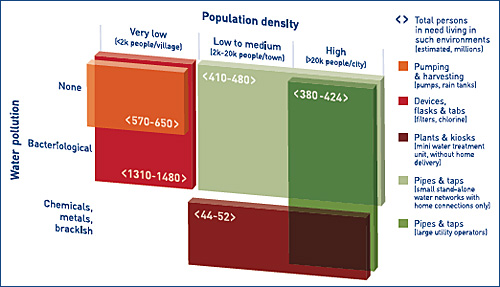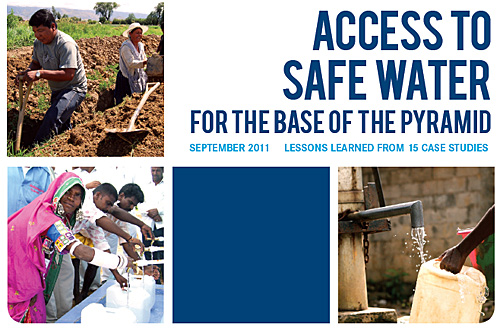Local enterprises hold key to low cost water supply in developing countries
To be able to upscale the low cost water supply in developing countries through so called non-piped interventions, it is important to raise awareness amongst potential consumers and to incubate a set of local enterprises that can copy the best local approaches, for instance the sale of water treatment devices, the servicing of a pumping place or a water kiosk. Such efforts cannot be borne by private players alone, and should be supported by philanthropic and public institutions.
This is one of the main outcomes of the study ‘Access to safe water for the base of the pyramid’ done by the Dutch water aid foundation Aqua for All, the foundation BoP Innovation Center and the consultancy firm Hystra.
The study on alternative low cost water supplies in developing countries, started with the identification of some 140 projects across the world and the interviews with 110 entrepreneurs, development specialists and water experts.
Four major clusters
This lead to the identifications of four major clusters:
- flacks & tabs - household purifying filters, tablets or chemicals
- pumping & harvesting - groundwater extraction and rain water collection
- plant & kioks - mini water treatment plants
- pipes & taps - a distribution system and a local operator
Finally 15 cases were selected and analysed in depth.

The scope of safe water solutions, in terms of appropriateness and
cost-effectiveness
Piped networks for urban areas
The in depth analyses of the cases learned that scaling-up access to safe water and reaching out to the 2.1 billion people without this common good is possible, and can even be profitable. For the fast growing urban population in developing countries - expected growth: almost 70% by 2030 - piped distribution networks seems to be the most appropriate.
Hybrid water utilities
Good opportunities lay ahead for utility operators (public and private), especially if they join forces and create hybrid water utilities formed by public, non-profit and private players. These partnerships can focus exclusively on serving fast growing communities in towns and slums of large cities.
The urban areas could be served with relatively low capital investments. For different reasons, such hybrid utilities could not be purely public or private, but rather require a blend of both, in terms of governance and financing.
Water kiosks for rural areas
For rural areas and areas where water is brackish/heavily polluted, other water solutions are better. The Hystra Project Team could identify successful individual projects, but the challenge is to develop – on that basis - entire industries to provide safe water for the poor and “to incubate many local enterprises that can copy the winning approaches”.
Scaling-up by private players alone
For areas with brackish/heavily polluted water there are plenty of opportunities for social entrepreneurs that can run mini-water-treatment stations (kiosks).
Scaling-up in rural areas can be realized by private players alone, but support from public and philanthropic institutions is needed to accelerate.
Acceleration of BoP-focused water industry
Extrapolating from the case study data, the Hystra Project Team estimates that over 6 billion US dollars will be needed to accelerate the development of BoP-focused safe water industries across all clusters. About one third of this amount would come from grants, while the rest would consist of loan and equity financing. Similarly, considerable financial innovation will be needed to create the right incentives for more corporates and investors to come in.
Read the original news release on the website of BoP Innovation Center.
Download Access to safe water for the base of the pyramid:
the report summary
or the full report
More information
Aqua for All
The Hague, the Netherlands
Marcel Schreurs, m.schreurs@aquaforall.nl
+31 70 351 97 20
or
BoP Innovation Center
Utrecht, the Netherlands
Taco de Nies, denies@bopinc.org
+31 30 230 59 15




